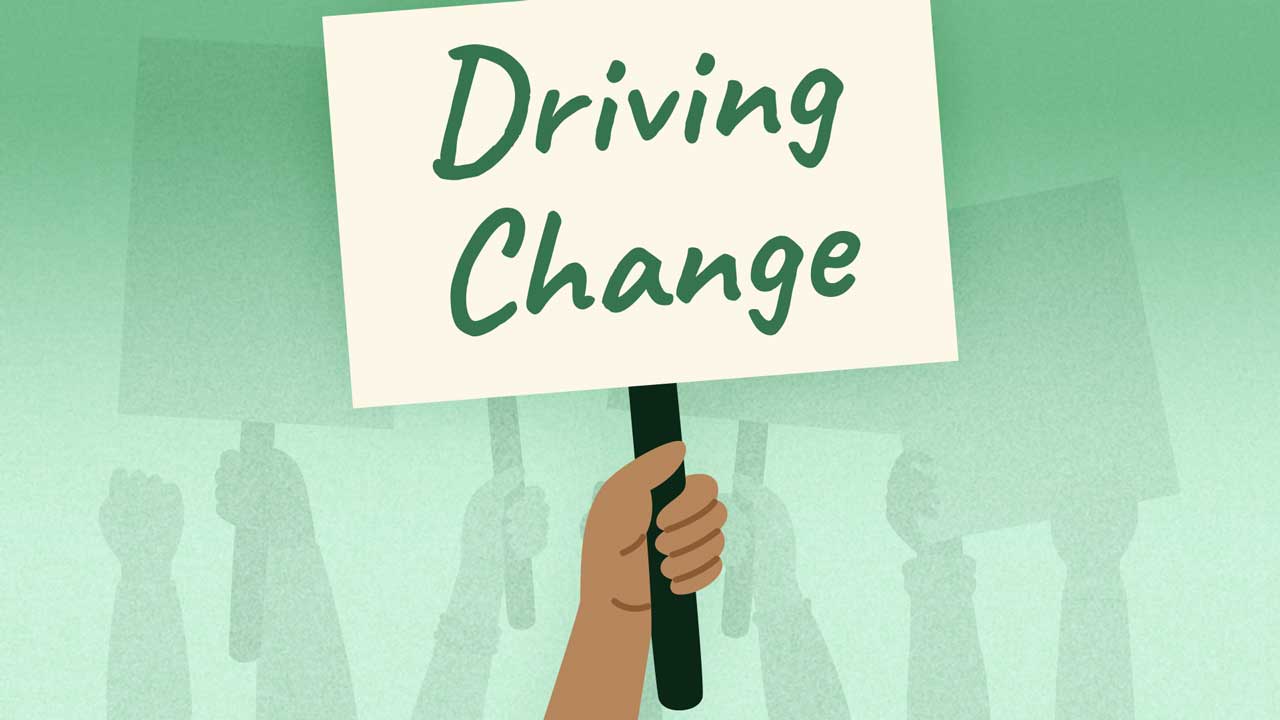Change is an essential but challenging aspect of nursing care (Udod & Wagner 2018).
Under Standard 1 of the National Safety and Quality Health Service Standards: Clinical Governance, organisations are responsible for facilitating continuous safety and quality improvements to their services (ACSQHC 2019).
But how can you, as an individual, drive change within your workplace?
John Kotter’s 8-Step Process for Leading Change
Throughout this article, we will be using John Kotter’s change model to demonstrate how you can drive change.
Note that Kotter’s model is one of many options. It will be used as an example in this article, but you may choose to use a different evidence-based model.
Kotter is a professor at Harvard Business School who is internationally known and widely regarded as a leading figure on the topics of leadership, management and change.
Kotter first introduced the 8-Step Process for Leading Change in his 1996 book Leading Change. In 2014, he updated and revised the model (LeStage 2015).
According to Kotter’s model, the eight steps are:
- Create a sense of urgency
- Build a guiding coalition
- Form a strategic vision and initiatives
- Enlist a volunteer army
- Enable action by removing barriers
- Generate short-term wins
- Sustain acceleration
- Institute change.
(Kotter 2018)
While there are eight separate steps identified, the aim is for all of these components to occur simultaneously and continuously (Kotter 2018).
Example Scenario
Suppose that you would like your facility to implement nurse-led protocols for urinary catheter removal (rather than only being able to remove catheters upon doctor’s orders), as research suggests they may contribute to decreased rates of catheter-associated urinary tract infection (CAUTI) (Durant 2017).

How can you use Kotter’s model to drive this change?
1. Create a Sense of Urgency
Kotter has found that a lack of perceived urgency is a common reason why many attempts to create change fail (Kotter 2018).
The key to creating urgency is to identify a window of opportunity that is open now but may close soon. When identifying this opportunity, it’s important to sell your idea to others in a way that will appeal to their hearts and minds while addressing the stakes of both success and failure. Enlisting others to support your idea is essential (Kotter 2018).
It may be helpful to perform a SWOT analysis at this stage to identify your proposal's potential strengths, weaknesses, opportunities and threats.
Using the example scenario:
- A possible strength is reduced waiting time for patients, as they will be able to have their catheters removed without waiting for a doctor’s permission.
- A possible weakness is premature catheter removal, which may cause complications.
- A possible opportunity is improved patient comfort.
- A possible threat is doctors being hesitant to lose control of the decision to remove catheters.
2. Build a Guiding Coalition
A guiding coalition is a group of allies within your organisation that is willing to unite behind your cause (Lucidchart 2019).
Your guiding coalition should comprise diverse people from different roles, departments and levels of the organisational hierarchy (Kotter 2018; Lucidchart 2019).
Using the example scenario, you could start building your coalition by engaging in conversations with your colleagues. You could:
- Mention the latest evidence that recommends nurse-led protocols
- Discuss the cost that CAUTIs currently cause for your organisation
- Emphasise the importance of providing safe and improved patient care
- Provide example scenarios and describe potential outcomes, including the risk of keeping the existing system
- Suggest how you could combat potential threats (e.g. others being reluctant).
These discussions will help to create a sense of urgency.
3. Form a Strategic Vision and Initiatives
According to Kotter (2018), strategic initiatives are ‘targeted and coordinated activities that, if designed and executed fast enough and well enough, will make your vision a reality’.
A good strategic vision is the backbone of your strategic initiatives (Kotter 2018). It should be:
- Motivational
- Able to coordinate and align people’s actions
- Able to express how the future will differ from the past
- Communicable
- Desirable
- Able to create a verbal picture
- Flexible
- Feasible
- Imaginable
- Simple.
(Kotter 2018)
Ensure that your strategic vision is clear and understandable, embodying the core values of your proposal. Your coalition should be able to clearly communicate your vision (Lucidchart 2019).
Using the example scenario, your vision might be earlier patient discharge and reduced costs. It’s beneficial to link your vision with the visions or strategies of your organisation; that way, you are strengthening a vision that already exists rather than trying to introduce something brand new.
Creating a ‘mission statement’ that summarises your vision is also beneficial, for example, ‘evidence shows that nurse-led protocols improve patient’s overall health outcomes’ (Lucidchart 2019).
4. Enlist a Volunteer Army

This step involves building excitement around your proposal in order to bring colleagues on board. Rather than making others feel like they have to contribute, it’s much more beneficial to make them want to participate on their own accord (Kotter 2018).
With a powerful vision, you can encourage others to participate. Once they become involved, it’s important to recognise their efforts so they remain engaged (Kotter 2018).
According to Kotter (2018), while having a large number of people on board is beneficial, just 15% of your organisation is enough to create momentum towards your proposal.
Enlisting a volunteer army involves talking to others about your idea frequently and communicating your vision in a powerful way so that it stays in people’s minds. Using the example scenario, you might talk to colleagues, managers and patients about the benefits of nurse-led protocols. Be honest and address people’s concerns if they arise.
5. Enable Action by Removing Barriers
Identify potential barriers and consider how they have caused past attempts to change to be unsuccessful. Consider how far previous attempts at change were able to progress before failing (Kotter 2018).
Potential barriers include:
- Narrow-mindedness
- Complacency
- Rules and procedures
- Limited access to stakeholders
- Statements such as ‘it’s just not done that way’ or ‘we tried that before and it didn't work’.
(Kotter 2018)
Once you have identified barriers, try to remove as many of them as possible. Identify people who are resistant to your proposal and address their concerns (Lucidchart 2019).
Using the example scenario, suppose that you find time constraints to be a barrier. Perhaps you could schedule meetings during lunch so that you can have regular discussions with your coalition.
6. Generate Short-term Wins
Anything that moves you towards your goal, whether it be small or large, can be considered a win. An effective win is relevant, tangible, visible and clear. It should be something that others are able to replicate or adapt and should have meaning for colleagues, patients and others involved (Kotter 2018).
Examples of short-term wins include:
- A particular action being taken
- A lesson being learned
- A process that has been improved
- A new behaviour that someone has demonstrated.
(Kotter 2018)
Using the example scenario, a short-term win could be the nurse unit manager - someone with influence - joining your coalition. Or, it could be being invited to attend a leadership or management meeting where you can present your rationale for implementing nurse-led protocols.
To keep your coalition motivated, reward those who help achieve these short-term wins (Lucidchart 2019).

7. Sustain Acceleration
Use the momentum generated from short-term wins to move closer to your goal and maintain the urgency that you established in the first step. Continue to recruit people to your volunteer army and identify more barriers to remove (Kotter 2018).
At this stage, it is a good idea to reflect upon what has and has not been working so far. Gradually, you can set new goals that are more ambitious than the last (Lucidchart 2019).
Using the example of attending a leadership or management meeting in step six, step seven could mean reflecting upon that meeting and how your idea was received, then setting new goals to drive you closer to victory.
8. Institute Change
The final step is about creating lasting change and new long-term behaviours. You need to find ways to sustain your change and incorporate it into the workings of your organisation. This can be achieved by anchoring new practices to older ones while removing parts of the older processes that are no longer needed. Link new practices to the success of your organisation in order to cement them (Kotter 2018).
In order to permanently implement change, continue to discuss your progress, recognise those who have contributed and instil your values into new colleagues (Lucidchart 2019).
Test Your Knowledge
Question 1 of 3
Which one of the following is an example of a threat when conducting a SWOT analysis?
Topics
References
- Australian Commission on Safety and Quality in Health Care 2019, Clinical Governance Standard, Australian Government, viewed 10 January 2024, https://www.safetyandquality.gov.au/our-work/clinical-governance/clinical-governance-standard
- Durant, DJ 2017, ‘Nurse-driven Protocols and the Prevention of Catheter-associated Urinary Tract Infections: A Systematic Review’, American Journal of Infection Control, vol. 45, no. 12, viewed 10 January 2024, https://www.ajicjournal.org/article/S0196-6553(17)30907-0/pdf
- Kotter, JP 2018, 8 Steps to Accelerate Change in Your Organisation, Kotter International, viewed 10 January 2024, https://www.kotterinc.com/research-and-perspectives/8-steps-accelerating-change-ebook-2020/
- LeStage, G 2015, ‘How Have Kotter's Eight Steps for Change Changed?’, Forbes, 5 March, viewed 10 January 2024, https://www.forbes.com/sites/johnkotter/2015/03/05/how-have-kotters-eight-steps-for-change-changed/?sh=6ae53e63c7b6
- Lucidchart 2019, How to Implement Change with Kotter’s 8-Step Change Model, Lucidchart, viewed 10 January 2024, https://www.lucidchart.com/blog/kotters-8-step-change-model
- Udod, S & Wagner, J 2018, ‘9 Common Change Theories and Application to Different Nursing Situations’ in J Wagner J (ed.), Leadership and Influencing Change in Nursing, University of Regina Press, Canada, viewed 10 January 2024, https://leadershipandinfluencingchangeinnursing.pressbooks.com/chapter/chapter-9-common-change-theories-and-application-to-different-nursing-situations/
 New
New 
